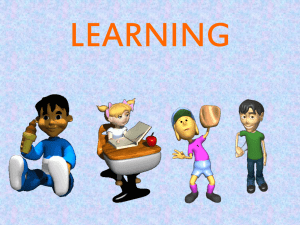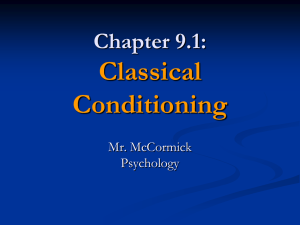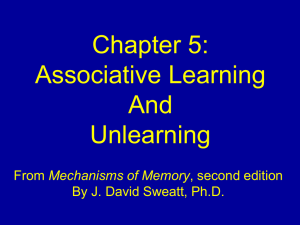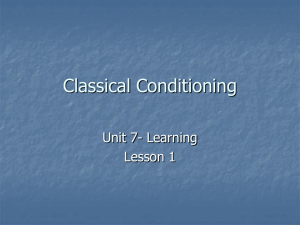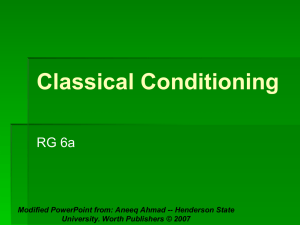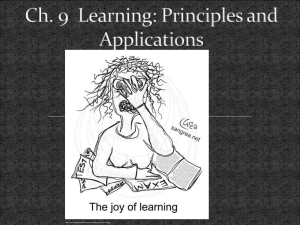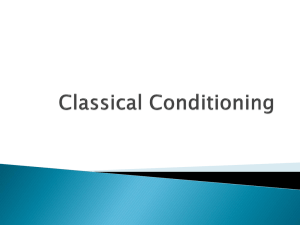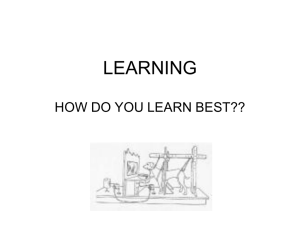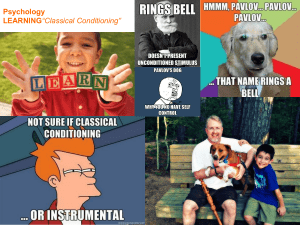LEARNING
advertisement
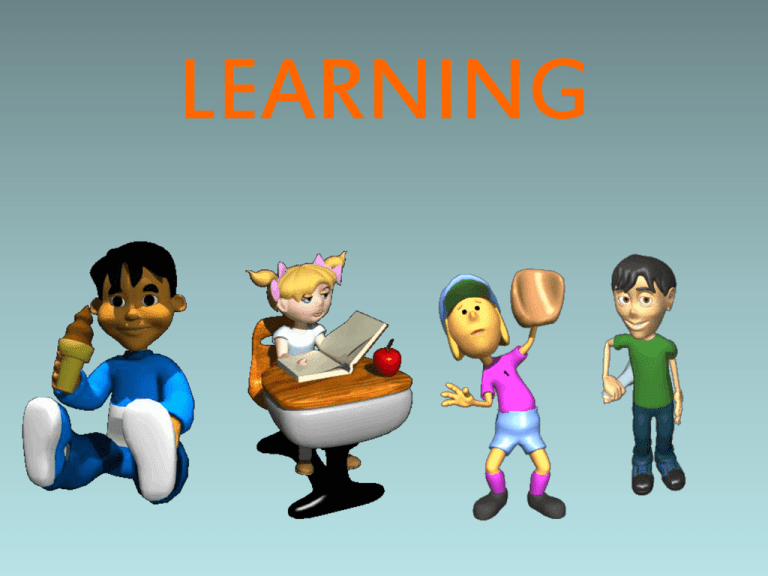
LEARNING Learning • What does it mean to learn something? • How do you know you’ve learned? Adaptability • Our capacity to learn new behaviors that enable us to cope with changing circumstances Successful Adaption • Successful adaption requires both nature (the needed genetic predispositions) and nurture (a history of appropriate learning). Example: Infants to 5 year olds learn to associate different facial expressions with their accompanying behaviors and tones of voice. Learning • A relatively permanent change in behavior that results from experience interacting with the world • Seal balances ball receives food • Balances ball again to gain more food How do we learn? Most learning is associative learning • Learning that certain events occur together • Linking two events = Classical Conditioning Operant Conditioning Observational Learning Classical Conditioning • Do you cringe at the sound of a dentist’s drill?? • Do you salivate when passing your favorite restaurant?? • How did you learn these behaviors? • It all started with Ivan Pavlov, his dogs, and classical conditioning Classical Conditioning • A type of learning where a stimulus (something that we can respond to) gains the power to cause a behavior or action • In Pavlov’s case the stimulus was the food – What behavior did it cause in the dogs?? • Others stimuli?? – What about Psychology class?? – What power does it have? Operant Conditioning • This is the Reinforcement and punishment type of learning – Learning in which the frequency of a behavior depends on the consequence that follows that behavior – Touching a hot oven • learn not to touch same hot oven because of reinforcement of behavior • burning hand “The Law of Effect” • “Any behavior that has good consequences will be repeated and any behavior that has bad consequences will be avoided” – Edward Thorndike Observational Learning • Learning by observing others – learning that occurs as a function of observing, retaining and replicating behavior observed in others Basic Concepts of Classical Conditioning Unconditioned Stimulus (UCS): a stimulus that naturally and automatically triggers a response. Leads To… Unconditional Response (UCR): the unlearned, natural reflex brought on by the UCS. Neutral Stimulus (N): a stimulus that before conditioning does not lead to a particular response X Conditioned Stimulus (CS): an originally irrelevant (neutral) stimulus that, after training (or pairing) becomes associated with the UCS. Conditioned Response (CR): the learned response to the CS Pavlov spent the rest of his life outlining his ideas. He came up with 5 critical terms that together make up classical conditioning. • • • • • Acquisition Extinction Spontaneous Recovery Stimulus Generalization Stimulus Discrimination Acquisition • The initial stage of learning something. • The phase where the neutral stimulus (NS) is associated with the UCS so that the NS comes to elicit the CR (thus becoming the CS). Does timing matter? YES WHY?? Ideally the UCS should be paired with the NS right away to gain the greatest level of conditioning Extinction • The diminishing of a conditioned response (CR) • Will eventually happen when the UCS does not follow the CS. Is extinction permanent? Spontaneous Recovery The reappearance, after a rest period, of an extinguished CR Involves reconditioning - - this conditioning will be learned much quicker Stimulus Generalization • The tendency, once a response has been conditioned, for stimuli similar to the CS to elicit similar responses. – The greater difference between the original stimulus and the related stimulus, the weaker the conditioned response is Stimulus Discrimination • The learned ability to distinguish between a CS and other stimuli that do not cause a response (CR) X Generalization, Discrimination, Extinction, or Spontaneous Recovery • Sinbad was frightened by a barking, lunging spaniel. Now he is afraid of all dogs. – generalization • Sheila was frightened by a German Shepherd when she was 5, but now she is happy whenever she sees a dog. – extinction • Nathan hates the sight of a bee, but loves to watch hummingbirds. – discrimination • When Kim was small, she got sick after eating a bad oyster. Now she reuses to eat anything that comes out of the sea. – generalization • Romeo loves the smell of his girlfriend’s perfume, but thinks all other kids of perfumes are unpleasant. – discrimination • Jamie had finally recovered from her fear of roller coasters, but one night when she was walking by the amusement park, the sudden screeching noise of the roller coaster made her heart jump in fear. – Extinction and Spontaneous recovery • Leonardo used to love the scent of his girlfriend’s perfume, but now that they’ve broken up, it’s just another odor to him. – extinction Exercise in Classical Conditioning The Office Conditioning How about fear? Are we born with it or do we acquire it?? Classical Conditioning and Little Baby Albert Important People in Classical Conditioning • John Watson and Rosalie Rayner – Little baby Albert and fear conditioning • Robert Rescorla – Importance of cognition in learning and conditioning – predicting events – knowing the difference between what is expected to happen and what actually happens – “Flush” example • John Garcia – Taste aversion • A dislike to a particular food or drink acquired through classical conditioning Hot water example • Every time someone flushes a toilet in the apartment building, the shower becomes very hot and causes the person to jump back. Over time, the person begins to jump back automatically after hearing the flush, before the water temperature changes. • • • • The hot water is the US The jumping back is the UR The toilet flush is the CS The jumping back to the flush alone is the CR The Balloon Experiment Someone pops a balloon with a needle, and we flinch or jump. The balloon popping is the UCS. Our flinch or jump is the UCR. But if we jump before the balloon pops just because we see the needle approaching the balloon, the needle becomes the CS, and our flinch becomes the CR. Commercials or Advertising We use the UCS, UCR, CS, and CR in our everyday lives. In a Nestea commercial they show people that are hanging out by a pool, it makes you feel cool or refreshed. The pool is the UCS and us feeling refreshed is the UCR. When you go to the store and see the Nestea brand iced tea, you feel refreshed because you learned that that’s how it’s advertised to make you feel. So the tea is the CS, and you feeling refreshed is the CR. Taste Aversion • Taste aversion is your avoidance of certain tastes, just because of how they taste, or how they make you feel. • John Garcia and Robert Koelling discovered a way to show how taste aversion could develop. They paired a nausea-producing drug with a certain food or drink. The drug that produces nausea is the UCS and the nausea, or you feeling sick, is the UCR. They would use that same food or drink with the nausea-producing drug repeatedly. Eventually just the thought, taste, or smell of that food could create nausea. So that food becomes the CS, and your nausea is now the CR. Classical Conditioning WS

